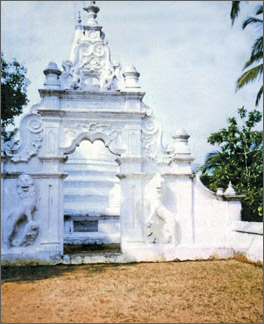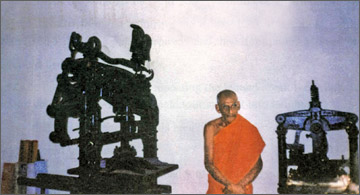|
First Sinhala newspaper:
Lankaloka
Padma Edirisinghe
In a country mostly populated by Sinhalese, it may appear rather
strange that newspapers in the Sinhala medium made their debut much
later than the English newspapers. But that was almost an inevitable
situation in a country predominated by the interests of the colonial
masters. So while a number of English newspapers were catering to the
English readership, Sinhala and (perhaps) Tamil papers were yet to see
the light of day.
|

Entrance to Chaitya at Ranwalla Temple, Katalwatha |
And when they did, they appeared in a very rudimentary form under
names as Novus Kadadasi (paper carrying news) and Aranchi patra. The
latter term came to general use though the first Sinhala newspaper, born
in June 1860 has used the term, Lankalokaya nam Patraya. Word Patraya or
Pattare has trailed over the years and centuries ever since then.
Lankalokaya was born in a press at Galle and in size was about a
foolscap paper. Price six pence. Publisher W A Etin who had published it
on behalf of Mudaliyar C W K Jayawardena. Editor William Perera
Ranasinghe though Dr K D G Wimalaratne had made a later correction as
that the real editor was Ven Bulathgama Dhammalankara Siri Sumanatissa
Thera According to Dr K D Paranavithana, Consultant to the Archives,
this venerable, was a close associate of the contemporary Siamese king
Chulalankara. When the royal friend had asked the Thera what he desires
as a gift he had, opted for a printing press and the king had made
arrangements to have one shipped from London. Today, this press that put
out Lankalokaya lies at Ranwella Temple off Kataluwa.
Researchers delving into the origin and evolution of Sinhala
newspapers have failed to lay hands on the initial copies of this
newspaper. The earliest copy now deposited in the Archives and claiming
discovery by Dr K D Paranavithana at Kumara Kande Vihara in Dodanduwa
when going through a bundle of old documents. Presented to the Archives
it has been the one issued on September 10, 1860. It is introduced as
the sixth Patraya of the first book whatever that means.
Lankalokaya has been issued (for some obscure reason) on the 10th and
24th of every month. Were these dates to fall on a Sunday the paper
would appear on the following Monday. That obviously makes it a
non-Sunday newspaper. The very first page has been allotted to
advertisements. Here is a typical advertisement the flavour of it
however lost in the translation into English, since the Sinhala used has
a rare indigenous and unsophisticated quality of its own sometimes
overlooking grammatical restrictions.
“A pound will be gifted to those who give us information on the
thieves who rob the food stored in the carriage stands of Habaraduwa,
Goiyapana and Mirissa, meant for the horses of the Matara bound
carriages”.
|

The first printing press owned by Sinhala Buddhists. It is now
in Ranwella Temple |
Talk of present day lawlessness! Were some of them as equally starved
as some, who cry today over the rise of COL, to descend to the level of
stealing food meant for animals? The world is certainly weird. Word used
for Matara bound carriages in this advertisement is Ashva Koachchi
(Horse-driven coaches). The word Koachchi (an adaptation of the English
word coach) stayed on to be used for the fuel powered Yakada Yakas long
after the horses were retired and is still bandied about in local use, a
popular alternative to the word, Dumriya, vehicle using steam.
The above advertisement has been inserted by Mohideen Bawa and
Company, who obviously were the businessmen who supplied food to the
horses, an indication that the Sinhala businessman like the Sinhala
newspaper was still lagging behind.
Yet to mitigate the majorly dry news conveying aspect it had
contained a few articles by Free-lancers on Ayurveda and religions.
Actually this paper supplied a God-sent opportunity to these writers as
literary-wise it was a very decadent age where native writers were a
forgotten lot. The rest of this paper was replete with local news
including news from the Courts and foreign news, the latter usually
copied from English newspapers whose editors were very generous to
supply these news, never considering the Sinhala papers as rivals, as
the readership was widely different.
Here is a specimen of the Court News.
“Number 6 - the charge against Galgoda Vidanalage Hamy, that of
letting cattle stray into the garden and killing them (?) is hereby
dropped on the advice of the Second Counsel of the Maheshika (Queen of
England).
Here is general news. “The family members of the deceased Governor
Ward including his Kumarihamy reached Galle Harbour last Friday”.
This news is rather mysterious for it is a commonly accepted fact
that only one British Governor (one of the two Andersons) died here. An
explanation can be provided by a reader. Perhaps the veteran writer
Tissa Devendra could help in.
And here is another bit of sensational news, revealing the forms of
punishment meted out to law-offenders in the early period of British
rule that covered a good part of the globe giving them a widely spread
out “punishment complex”.
“Of the 28 criminals shipped to Malacca six have died. There were two
notaries in that group, one of whom is Goonetileka of Harispattuwa”.
Criminals had also been sent to Cape Town in Africa. The hazardous
oceanic trip itself was a punishment and many died on the way. Some were
also sent to Mauritius. Its most famous Sri Lankan prisoner was
Ehelapola Maha Adikaram who of course lived long to undergo a natural
death. His tomb lies there. Now all that is mine and not published in
Lankalokaya that seemed not to have carried long narratives. Anyway
there seems to have been a Letters to the Editor column, that eventually
became very popular feature. For it exercised the creative talent of
many writers in the country, their talents “withering in the desert
air”. Many however wrote under assumed names fearing retribution,
especially when they criticized State actions. These names themselves
were very creative. But they progressed as a vibrant component of the
Sinhala newspapers in the later papers such as Lakminipahana that
followed Lankalokaya which seems to have been an improvement on
Lankalokaya. The venue of publication too changes from Galle to Colombo,
to No 77 of “Vonvondaal Strret”, a premise graced by elephants! Etun
Bandi watte. Editor Jayasuriya Arachchige Hendrick Perera. However, we
must remain grateful to those enterprising “actors” behind the maiden
Sinhala newspaper for daring to break into new ground at a time when it
was considered that the major race did not deserve a paper using its own
language.
Writer is indebted to Siri Thilakasiri, author of 19th C Sri Lanka
for some of these facts |



